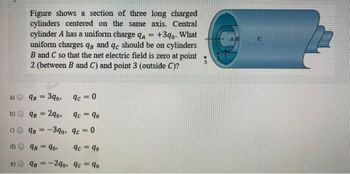Question

Transcribed Image Text:b)
C)
=
Figure shows a section of three long charged
cylinders centered on the same axis. Central
cylinder A has a uniform charge qA
+3qo. What
uniform charges qs and qc should be on cylinders
B and C so that the net electric field is zero at point
2 (between B and C) and point 3 (outside C)?
9B = 390,
9B = 290,
9c=0
9c = 90
9B-390, 9c=0
98 90,
9c = 90
9B-290, 9c = 90
1
C
Expert Solution
This question has been solved!
Explore an expertly crafted, step-by-step solution for a thorough understanding of key concepts.
This is a popular solution
Trending nowThis is a popular solution!
Step by stepSolved in 3 steps with 3 images

Knowledge Booster
Similar questions
- A non-conducting sphere 15.0cm in diameter has a total charge of 2.25µC distributed uniformly throughout its volume. Plot the magnitude of the electric field, E, as a function of the distance, r, from the center of the sphere, from r =0cm to r =30.0cm. (The graph must be madeon computer)arrow_forwardA thin cylindrical shell of radius R₁ = 4.5 cm is surrounded by a second cylindrical shell of radius R₂ = 9.5 cm, as in ( Figure 1). Both cylinders are 15 m long and the inner one carries a total charge Q₁ = -0.68 nC and the outer one Q2 = +1.56 nC. Figure RR R₂ 1 of 1 Part A If an electron (m = 9.1 x 10-31 kg) escaped from the surface of the inner cylinder with negligible speed, what would be its speed when it reached the outer cylinder? Express your answers with the appropriate units. Ve= Submit Part B Up = Submit Value 0 μÅ If a proton (m = 1.67 x 10-27 kg) revolves in a circular orbit of radius R = 7.0 cm about the axis (i.e., between the cylinders), what must be its speed? Express your answers with the appropriate units. Request Answer Provide Feedback ī μA Value Units Request Answer wwww ? Units ?arrow_forwardThe drawing shows two situations in which charges are placed on the x and y axes. They are all located at the same distance of 5.00 cm from the origin O. For each of the situations in the drawing, determine the magnitude of the net electric field at the origin. -l.0 μC +1.0 uC +2.0 uC -3.0 µC +4.0 µC -1.0 uC o! +6.0 uC (b) (a)arrow_forward
- In the figure, the four particles are fixed in place and have charges q, = q2= 5e, q3 = 3e, and q4 = -12e (e = 1.6 × 10-19 C). Distance d= 5.0 µum. What is the magnitude of the net electric field at point P due to the particles? 4 Give your answer in N/C. (ke = /4ne, = 9.0 × 10° Nm²/C²)arrow_forwardThree charges are on the plane (x,y) as reported on the picture. The two charges q on the x-axis are equal and at distance of 8 cm from the origin. The charge on the y-axis is negative and 3q and it is at 16 cm from the origin. Determine the x component of the electric field at the point P (0,5) cm. q P -39 qarrow_forwarda) At what distance from a particle with a charge of 6.00 nC does the electric field of that charge have a magnitude of 4 N/C? The distance =arrow_forward
arrow_back_ios
arrow_forward_ios